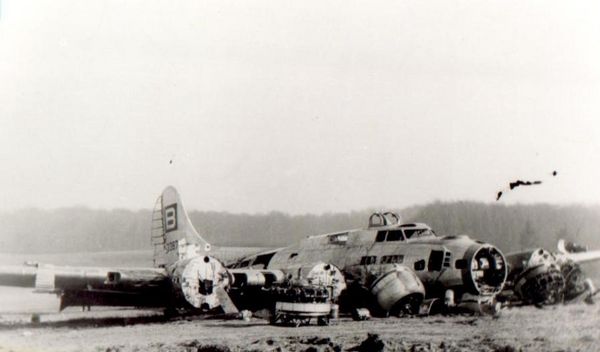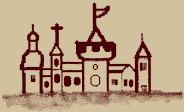Christmas Eve 1944 - Mission to Biblis, Germany
On December 24, 1944, the 8th Air Force was bombing various airport runways in Germany so that the Germany could not aid their troops with fighter support. We were assigned to bomb the runways near Frankfurt am Main at a place called "Biblis", and for some reason, the lead ship failed to drop on the initial bomb run. We were at 22,000 feet altitude and the target conditions were visual. Staring with the initial point and on the run to the target the flack was heavy and extremely accurate.
In the 12 plane squadron, we were flying on the left wing of the low element, often laughingly referred to as "purple heart corner".
At the briefing prior to take off, we were informed that if the lead could not drop, the lead ship was to make a diving turn to the left or right and lose approximately 1,000 to 2,000 feet in altitude with the squadron and then regroup into tight formation, and we were to proceed to an alternate target. However, the lead chose not to follow instructions and made a standard rate 180° turn at constant altitude and air speed, and returned to the initial point and made a second run on the Biblis target (located south of Frankfurt) along the same identical flight path. On the way in, several of our ships were hit, including ourselves. I believe that Snyder, our radio operator, had a piece of flak pass between his legs, just below his crotch, ripping his cloth and flying suit, but not injuring him seriously.
About 1 to 2 minutes before "dropping", late in the bomb run, we received almost a direct hit with the shell exploding just below and between the fuselage and the number three engine. It's hard to remember all that happened, but I believe that there was a hole ripped in the fuselage near the floor by my left foot. The hydraulich lines in this area were severed and pink hydraulic fluid was spraying on my left boot.
Upon being hit, we pealed off to the left and I did not realize that we were on fire until one of the crew members called in on the intercom saying the left wing was on fire. We immediately went into a steep dive to blow out the fire and in so doing, dove into a cloud bank which lit up brillantly, I am told, causing our other squadron members to report that we had blown up.
The fire blew out and we possibly lost 10,000 feet in blowing it out.
After pulling out of the dive or along the way somehow feathered three of the engines which had been knocked out by the flack shell damage. I think it was probably oil from a severed oil line in the left wing that was burning and not gasoline.
Only the number two engine was still operable and we turned the turbo charger on this engine from maximum to "war emergency", a condition that could be used for only two minutes without ruining the engine. This engine stayed wide open at war emergency until the final ditching.
Immediately after the dive, our crew members threw everthing they could break loose from the airplane, to reduce weight; including ammunition, flack suits and 50 caliber machine guns. With this reduced weight and with the engine cow flaps tightly closed to reduce drag and with approximately one third wing flap down to give maximum lift, by trial and error, we were finally able to stabilize our descent at about 50 feet per minute. Our air speed on descending was just slightly above the stalling point for maximum glide.
McEwen, our navigator, had previously plotted the shortest course out of enemy territory and we were following that course. At the morning's briefing, McEwen had plotted the latest report on the front line positions.
As we approached the town of Bitch, France, at an altitude of 5,000 or 6,000 feet, we encountered heavy flak and veered sharply to the right taking evasive action and no hits. We had previously advised the crew to connect their parachute packs to their harness and connect the shroud line for jumping and to stay on the intercom for instructions. Immediately after passing Bitch, we advised that we doubted if we could avoid landing in enemy territory, even if we waited until we were down to an altitude of 3,000 to 2,500 feet before jumping.
Co-Pilot Ted Harris suggested that he and I ride it down as we felt we might just clear enemy territory. We so advised the crew and those that preferred to jump to line up by the rear door with shroud lines connected and I would give the count in approximately one minute. Those that preferred to ride down with Harris and I should proceed immediately to the radio room and take ditching positions. At approximately 3,000 feet, we gave the bail-out count. We were over fairly rough terrain, very hilly and semi-mountainous at this point.
In the distance we could see forest patches and open fields. The smoke from the stacks of a small town showed that the wind wa pretty much out of the southeast and strong. At about 1,500 feet, we chose a long field parallel to a road running almost East and West at that point and with the plowed furrows also running in that direction.
With the field that we had chosen now off our right wing tip, we made a sharp turn to the right for our down wind leg, with the field still to our right, and then made a 180° turn to the right, southeast into the wind.
Power on the inboard right engine had been cut back for the right hand turn, and as we started to come out of the turn, I chopped it completely. Sometime previously, I can't remember when, Harris had had the ball turret lowered and the guns positioned downward and to the rear to act as a skid. On the final approach, we opened the bomb bay doors which increased our drag, fortunately; but the main obejctice was to act as an air trap or cushion if such was possible when stalled out, hopefully just above the ground.
The woods on our left was angling in towards the road we were paralleling, to our right.
At about 50 feet altitude and at about 90 miles indicated air speed, I noticed a drainage ditch running directly across our probable "set down" and "slide path", so the number two engine was given one slight burst of power and chopped off.
It seemed like we would float forever. We were now going definitely uphill just above the ground. She finally stalled out and being empty and so light, probably landed at around 65 miles per hour indicated airspeed and with a strong head wind; we probably touched the ground at 45-50 miles per hour.
It was a smooth landing but it sounded like somone had dropped a load of metal dishpans. We hardly skidded at all when we came to a sudden stop - like someone had put the brakes on. Dirt and debris flow all over the cockpit as the air trapped in the bombay section, when we dropped to the ground, blew the door from the bombay to the cockpit open. We immediately buckled our safety belts and Harris excited by the right window and I by the left.
Standard practice was to remove the parachute harness and go out the window backwards and sitting on the ledge of this narrow opening to grab the barrel of the fifty caliber gun and pull your seat and legs out the window and hanging from the gun barrel, then drop down the side of the fuselage to the ground; in practice, it was water.
With no gun barrels to grab hold of, we made it anyway; how ... I cannot recall as it was a considerable drop to the ground even with the wheels up and the belly of the plane on the ground.
I ran around the front of the plane joining Harris and the crew as we headed south for the road. Looking back from the road, I can barely remember sseing the ball turret and fifty caliber guns which were ripped from the undercarriage and laying behind the plane. Between the plane and the ball turret werethe bombay doors which had torn loose on touchdown.
The switch had been set in the radio room so that the plane would be ignited two or three minutes after touchdown. Now either the landing was so smooth that the switch didn't toggle or it just didn't work. I prefer the former opinion.
Back to Duty


